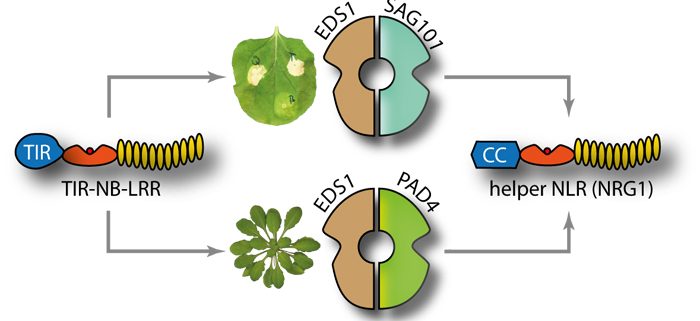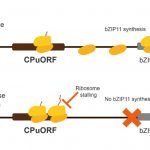Unexpected immune signaling complexity between plant species
Gantner et al. establish N. benthamiana as a new system for analysis of immunity mediated by TIR-type immune receptors Plant Cell. https://doi.org/10.1105/tpc.19.00099
By J. Gantner and J. Stuttmann
Background: Plant pathogenic bacteria inject effector proteins inside the plant cell during infection. In resistant plant lines, effectors can be recognized by intracellular immune receptors (“NLR receptors”), which prevents plant disease. NLRs are divided in two main classes. Those receptors containing a TIR (Toll-interleukin-1 receptor) domain require complexes based on the protein EDS1 (ENHANCED DISEASE SUSCEPTIBILITY 1) to confer resistance. EDS1 forms mutually exclusive complexes with two sequence-related proteins, PAD4 (PHYTOALEXIN-DEFICIENT 4) or SAG101 (SENESCENCE-ASSOCIATED GENE 101). EDS1 and PAD4 are highly conserved, and can be found within the genomes of all higher plants. In contrast, SAG101 is only found in those plants that also have TIR-type immune receptors. So far, EDS1 functions were mainly analyzed in the model Brassicaceae plant Arabidopsis thaliana, in which the EDS1-PAD4 complex is most important for immune functions. However, molecular functions of EDS1 complexes yet remain unknown.
Question: We set out to analyze functions of EDS1 complexes in a different model species, Nicotiana benthamiana. N. benthamiana is genetically more complex than A. thaliana, but has advantages for functional analyses.
Findings: By genome editing (CRISPR/Cas) of EDS1, PAD4 and SAG101 and infection assays, we discovered that EDS1 and a SAG101 isoform (but not PAD4) are required for immune responses in N. benthamiana (a Solanaceae plant). However, when we transferred genes between plant species, we were surprised to discover that Solanaceae EDS1-PAD4, but not EDS1-SAG101 can fulfil immune functions in A. thaliana. This unravels an unexpected complexity in immune signaling pathways in different plant species, and implies that EDS1 complexes co-evolve with other cellular components to execute immune functions. Furthermore, we used transient reconstitution assays, the prime advantage of the N. benthamiana system, to identify features of EDS1 complexes required for plant immunity.
Next steps: Other recent studies showed that “helper NLRs”, that do not contain a TIR domain and can most likely induce resistance responses by directly interfering with cell membrane integrity, are required downstream of EDS1 complexes. Transient reconstitution assays in the N. benthamiana system established here will be instrumental to answer the pressing question how EDS1 complexes connect TIR domain-containing immune receptors with helper NLRs to convey immunity.
Johannes Gantner, Jana Ordon, Carola Kretschmer, Raphaël Guerois, and Johannes Stuttmann (2019). An EDS1-SAG101 Complex is Essential for TNL-mediated Immunity in Nicotiana benthamiana. Plant Cell. https://doi.org/10.1105/tpc.19.00099
Keywords: Plant immunity, TIR-NB-LRR receptors, EDS1, N. benthamiana




